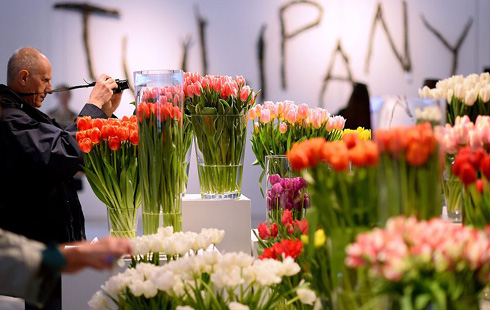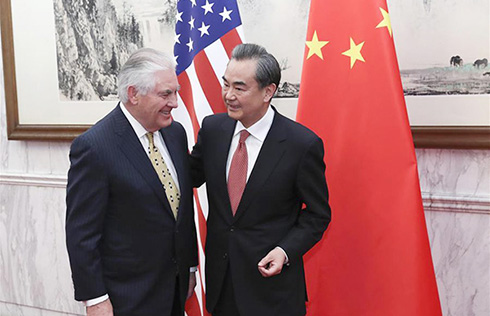China looks to take next step in global art world
Auctioneers must improve integrity to move up to the next level, say experts. Lin Qi reports
Last year, China took the largest share of the market in global sales of art and antiques at open auctions. However, if one adds up transactions at auctions and through dealers and galleries, China ranked third by value, after the United States and the United Kingdom, according to a recent report.
|
 |
|
A Qing Dynasty (1644-1911) painting album of Chinese roses fetches 173.6 million yuan ($22 million) at a Beijing auction. [China Daily] |
The first Art Basel and UBS Global Art Market Report said Chinese auction sales accounted for 34 percent of the world total by value, exceeding the US, which recorded 32 percent, and Britain, which had 18 percent.
However, China falls behind those countries when the bigger art industry picture is taken into consideration, because deals are also made by dealers and galleries at sales exhibitions and art fairs, as well as via expanding online sales.
The report said the US maintains the premier position. It accounts for 40 percent of global share by value, followed by the UK with 21 percent and China with 20 percent.
It also said the global art market generated $56.6 billion in total sales, and the top three markets-the US, UK and China-cemented a combined dominant position that has endured for a decade.
The report was published by Art Basel, an international art fair, and UBS during the fifth Art Basel Hong Kong event, held from March 23 to 25. It navigates the current trends in the global art and antiques trade, and analyzes the performances of auction houses, dealers and online sales.
The report was written by Clare McAndrew, founder of Arts Economics, a researcher and consultancy in Dublin. McAndrew based her analysis on market statistics provided by several institutions, including Collectrium, an international art collection management platform that provided the bulk of data, and the Art Market Monitor of Artron, of Artron Art Group, which provided Chinese auction data.
McAndrew said China's leading auction sales is the result of a decline in US auction sales and a "relatively stable performance at the high end" (objects sold for more than $1 million) in domestic salerooms.
High prices
Last year, Chinese auctions saw several expensive sales in the classical Chinese paintings and antiques market. A 14th-century colored ink-brush painting went for more than 303 million yuan ($44 million) in a December sale in Beijing. A 15th-century blue-and-white dragon-patterned jar grossed HK$158 million ($20 million) in a Hong Kong sale.
Works of 20th-century ink-brush masters also hit mind-boggling heights. Fu Baoshi's The God of Rain and The Lord of Fate, and Zhang Daqian's Peach Blossoms each sold for more than 220 million yuan, ranking them among the top three Chinese paintings at auction last year.
The annual report of the China Association of Auctioneers shows that there were about 436 houses in the mainland's art and antiques auction market by the end of 2015.
According to the Art Basel and UBS report, auction sales dominated the market in China, with a share of almost 68 percent by value.
Ji Tao, an art market observer in Beijing, said China's art auction market is immature in terms of scope and scale when compared with those in the US and Europe, and it needs to become more globalized to narrow the gap with those dominant markets.
He said almost all the objects in domestic salesrooms are Chinese works of art and antiquity, while buyers can find a variety of pieces from across the world at auctions in New York, London and other art hubs, which have attracted Chinese buyers who are diversifying their cultural properties.
"What the domestic market offers is quite homogeneous, but it means the homegrown market has great potential to develop into a global art trade center," Ji said.
To achieve that goal, which is a long-term commitment, Chinese auction houses should also expand their domestic brand influence to the international stage.
According to the Art Basel and UBS market report, three Chinese auction houses-Poly, Guardian and Council, which all arrange sales in the Chinese mainland and Hong Kong-are ranked in the highest tier, based on reported total sales at public auctions. They come after Christie's and Sotheby's, the long-time market leaders which have histories of more than 250 years.
Rapid expansion
The three Chinese art brokers are no more than 25 years old. Guardian, the oldest, was established in 1993 and hosted the mainland's first art auction. Its business has expanded rapidly during the past two decades.
Ji, the art observer in Beijing, said domestic auction houses mainly cater to Chinese people at home and abroad. Moreover, the buyers and the sources from which auction houses find objects to sell are mostly Chinese.
"It will take a long time for local houses to build an international, competitive brand," he said.
International houses have also flourished in online auctions, which have been well received by the younger generation of collectors, including those from China. While the Chinese market hasn't seen a boom in online auctions because few houses offer regular sales, Christie's noted that buyers from China accounted for 90 percent of their online sales of Chinese paintings. Following the success of an online sale of Chinese ceramics from the collection of the Metropolitan Museum of Art last year, Christie's is hoping for another stellar performance as demand for highly decorated porcelain in the Asian markets continues to grow.
"Quality and provenance are always important to our clients and attract international buyers to our online sales, as they do our live auctions," said Samantha Phillips, Christie's global head of online sales of Asian arts.
The insatiable appetite of Chinese buyers doesn't stop at Asian art. The auction house Fellows, which specializes in jewelry and watches but has the occasional Asian artwork on the block, has seen a 30 to 40 percent increase in Chinese clients in the last 12 months.
"Chinese buyers are more determined than their European counterparts," said Stephen Whittaker, the managing director. "For Asian art pieces, for example, I think Chinese bidders are culturally more attached to them."
Strengthen integrity
According to Ji, the Chinese market also has to strengthen its integrity. He said there has been fewer counterfeit antiques at auction in recent years, and fewer swindles in salerooms, some of which use hired shrills who pretend to bid but actually push up prices and mislead other bidders. He added that there are still doubts about the integrity of some sales, especially when they hit top prices.
The market analysis provided by Basel and UBS said Chinese auctions reported an unsold rate of 55 percent; much higher than in 2004, when it was 35 percent, and in other countries-for example, the US market has an unsold rate of 26 percent.
The report explained that the high rate indicates "a continuing problem with fakes in the market", and it is the result of a glut of lower-quality objects and insufficient number of top-quality works with sound sources of origin that are sought by collectors.
McAndrew said most dealers and auction houses in China agree that sourcing high-quality works remains a big challenge, despite demand far outstripping supply.
Chinese auction houses also deal with the recurring issue of late or nonpayment by winning bidders.
The Art Basel and UBS report further revealed that the rate of nonpayment has risen in recent years, with a rise of 5 percent annually from 2013 to 2016.
"To reach international standards, Chinese auctioneers should learn more about how to win the respect of their clients, counterparts and other circles of society, so they can achieve sustainable success," Ji said.
In a statement in the market report, Mark Haefele, global chief investment officer at UBS Wealth Management, said by its nature art will not deliver some of the features crucial to long-term investment propositions, which are more readily found in more-traditional financial assets.
"What art can give us is different, however, and in some ways it is worth more," he said.
"Art offers pleasure, passion, the thrill of a new perspective, and, ultimately, the chance to leave a legacy that goes beyond money."
Bo Leung in London contributed to the story.
Contact the writer at linqi@chinadaily.com.cn

























